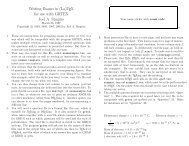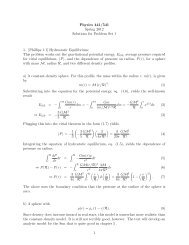Solutions
Solutions
Solutions
You also want an ePaper? Increase the reach of your titles
YUMPU automatically turns print PDFs into web optimized ePapers that Google loves.
MasteringPhysics: Print View with Answers http://session.masteringphysics.com/myct/assignmentPrin...<br />
3. Interference and Diffraction (Ch. 35, 36)<br />
Due: 11:59pm on Monday, February 18, 2013<br />
Note: To understand how points are awarded, read your instructor's Grading Policy.<br />
Interference in Soap Films<br />
Signed in as RONALD GILMAN, Instructor Help Sign Out<br />
Rutgers Analytical Physics 750:228, Spring 2013 ( RUPHYS228S13 )<br />
My Courses Course Settings<br />
University Physics with Modern Physics, 13e<br />
Young/Freedman<br />
Course Home Assignments Roster Gradebook Item Library<br />
3. Interference and Diffraction (Ch. 35, 36) [ Edit ]<br />
Overview Summary View Diagnostics View Print View with Answers<br />
Description: Short quantitative problems on destructive interference in thin films. Based on Young/Geller Quantitative Analysis 26.2.<br />
The sketch shows a thin film of soapy water of uniform thickness and index of<br />
refraction suspended in air. Consider rays 1 and 2 emerging from the film: Ray<br />
1 represents the reflected wave at the air-film interface and ray 2 represents the wave<br />
that reflects off the lower surface of the film.<br />
Part A<br />
Which of the following statements correctly describes rays 1 and 2 and their path difference?<br />
Check all that apply.<br />
Hint 1. Phase shifts from reflection<br />
When light reflects off a surface with a higher index of refraction, it undergoes a phase shift of half a cycle, which corresponds to a shift<br />
of half a wavelength. However, no phase shift occurs if light reflects off a surface with a lower index of refraction.<br />
Hint 2. Path length<br />
The light that reflects off the film-air interface has to pass through the film, where it will have a different wavelength. The total "extra"<br />
distance it travels is approximately twice the thickness of the film (since the light first travels through the film toward the film-air<br />
interface and then reflects back out into the air).<br />
ANSWER:<br />
Instructor Resources eText Study Area<br />
1 of 11 2/7/13 1:01 PM
MasteringPhysics: Print View with Answers http://session.masteringphysics.com/myct/assignmentPrin...<br />
Part B<br />
Ray 1 undergoes a half-cycle phase shift. Ray 2 does not undergo any phase shift.<br />
Both rays 1 and 2 undergo a half-cycle phase shift.<br />
Ray 2 undergoes a half-cycle phase shift. Ray 1 does not undergo any phase shift.<br />
The path difference between rays 1 and 2 is about .<br />
There is no path difference between the two rays.<br />
The path difference between rays 1 and 2 is about .<br />
Therefore, when calculating interference effects between rays 1 and 2, keep in mind that the actual phase difference of the corresponding<br />
waves will be given by both the path difference and the phase shift undergone by ray 1.<br />
When red light is directed normal to the surface of the soap film, the soap film appears black in reflected light. What is thinnest the film can<br />
be? Let be the wavelength of red light in air.<br />
Hint 1. How to approach the problem<br />
If the film appears black in reflected light, it means that the reflected light has undergone destructive interference. Using the information<br />
found in the previous part, apply the correct condition for destructive interference and solve for the thickness of the film.<br />
Hint 2. Find the correct condition for destructive interference in this thin film<br />
Which of the following relations (where is a positive integer) represents the correct condition for destructive interference occurring in<br />
a thin film of soapy water suspended in air and of thickness ? Assume that light is directed normal to the surface of the film and let<br />
be its wavelength in the film.<br />
Hint 1. Destructive interference in thin films<br />
Consider a thin film of thickness . Light is directed normal to the film surface. When either one of the two waves resulting from<br />
reflection at the upper and lower surface of the film undergoes a phase shift, destructive interference occurs when<br />
where is the wavelength of light in the film and is a positive integer ( ).<br />
Similarly, when neither or both of the two waves resulting from reflection at the upper and lower surface of the film undergo a<br />
phase shift, destructive interference occurs when<br />
where, again, is the wavelength of light in the film and .<br />
ANSWER:<br />
Since you need to find the thinnest film that can cause destructive interference, use this condition with and solve for .<br />
Recall that the wavelength of light in water is different than in air.<br />
Hint 3. Find the wavelength of red light in the soap film<br />
2 of 11 2/7/13 1:01 PM<br />
,<br />
,
MasteringPhysics: Print View with Answers http://session.masteringphysics.com/myct/assignmentPrin...<br />
If the wavelength of red light in air is , what is the wavelength of the same light in soapy water of refractive index ?<br />
Express your answer in terms of .<br />
Hint 1. Wavelength of light in a material<br />
The wavelength of light traveling in a material of index of refraction is less than the wavelength of the same light in<br />
vacuum. In particular, the wavelength of light in the material is<br />
where is the wavelength in vacuum. Note that the wavelength of light in air is essentially the same as that in vacuum.<br />
ANSWER:<br />
ANSWER:<br />
If we use white light instead of red, this film will reflect all colors that interfere constructively, but red will not be one of them.<br />
Thin Film (Oil Slick)<br />
Description: This problem explores thin film interference for both transmission and reflection.<br />
A scientist notices that an oil slick floating on water when viewed from above has many different rainbow colors reflecting off of the surface. She<br />
aims a spectrometer at a particular spot, and measures the wavelength to be 750 nanometers (in air). The index of refraction of water is .<br />
Part A<br />
=<br />
The index of refraction of the oil is . What is the minimum thickness of the oil slick at that spot?<br />
Express your answer in nanometers, to three significant figures.<br />
Hint 1. Thin film interference<br />
In thin films, there are interference effects because light reflects off the two different surfaces of the film. In this problem, the scientist<br />
observes the light that reflects off the air-oil interface, and off of the oil-water interface. Think about the phase difference that is created<br />
between these two rays. The phase difference will come from differences in path-length, as well as differences that are introduced by<br />
certain types of reflection. Recall that if the phase difference between two waves is (a full wavelength) then the waves interfere<br />
constructively, while if the phase difference is (half of a wavelength) the waves interfere destructively.<br />
Hint 2. Path-length phase difference<br />
The light that reflects off the oil-water interface has to pass through the oil slick, where it will have a different wavelength. The total<br />
3 of 11 2/7/13 1:01 PM<br />
,
MasteringPhysics: Print View with Answers http://session.masteringphysics.com/myct/assignmentPrin...<br />
Part B<br />
Part C<br />
"extra" distance it travels is twice the thickness of the slick (once as it moves toward the oil-water interface, and once as it reflects back,<br />
out into the air).<br />
Hint 3. Phase shift due to reflections<br />
Recall that when light reflects off a surface with a higher index of refraction, it gains an extra phase shift of radians. What used to be<br />
a maximum is now a minimum! Be careful, though; if two beams each reflect off a surface with a higher index of refraction, they will<br />
both get a phase shift, canceling out that effect.<br />
ANSWER:<br />
= 313<br />
Suppose the oil had an index of refraction of 1.50. What would the minimum thickness be now?<br />
Express your answer in nanometers, to three significant figures.<br />
Hint 1. Phase shift due to reflections<br />
Keep in mind that when light reflects off a surface with a higher index of refraction, it gains an extra phase shift. What used to be a<br />
maximum is now a minimum! Be careful, though; if two beams reflect, they will both get a phase shift, canceling out that effect. Also,<br />
reflection off a surface with a lower index of refraction yields no reflection phase shift.<br />
ANSWER:<br />
= 125<br />
Now assume that the oil had a thickness of 200 and an index of refraction of . A diver swimming underneath the oil slick is looking at<br />
the same spot as the scientist with the spectromenter. What is the longest wavelength of the light in water that is transmitted most easily<br />
to the diver?<br />
Express your answer in nanometers, to three significant figures.<br />
Hint 1. How to approach this part<br />
For transmission of light, the same rules hold as before, only now one beam travels straight through the oil slick and into the water,<br />
while the other beam reflects twice; once off the oil-water interface, once again off of the oil-air interface, before being finally<br />
transmitted to the water.<br />
Hint 2. Wavelength of light in air<br />
Find the wavelength of the required light, in air.<br />
Express your answer numerically in nanometers.<br />
ANSWER:<br />
Hint 3. The wavelength of light in water<br />
There is a simple relationship between the wavelength of light in one medium (with one index of refraction) and the wavelength in<br />
another medium (with a different index of refraction).<br />
ANSWER:<br />
= 600<br />
= 451<br />
4 of 11 2/7/13 1:01 PM
MasteringPhysics: Print View with Answers http://session.masteringphysics.com/myct/assignmentPrin...<br />
This problem can also be approached by finding the wavelength with the minimum reflection. Conservation of energy ensures that<br />
maximum transmission and minimum reflection occur at the same time (i.e., if the energy did not reflect, then it must have have been<br />
transmitted in order to conserve energy), so finding the wavelength of minimum reflection must give the same answer as finding the<br />
wavelength of maximum transmission. In some cases, working the problem one of these ways may be substantially easier than the other,<br />
so you should keep both approaches in mind.<br />
Using a Michelson Interferometer<br />
Description: A Michelson interferometer is used to find the wavelength of a laser and then the index of refraction for an unknown fluid.<br />
You are asked to find the index of refraction for an unknown fluid, using only a laser and a Michelson interferometer. A Michelson interferometer<br />
consists of two arms--paths that light travels down, which end in mirrors-- attached around a beam splitter. The beam splitter separates the<br />
incoming light into two separate beams and then recombines them once they return<br />
from the ends of the arms. The recombined beams are sent to a telescope, where their<br />
interference pattern may be observed in detail.<br />
Part A<br />
Part B<br />
First, you must find the wavelength of the laser. You shine the laser into the interferometer and then move one of the mirrors until you have<br />
counted fringes passing the crosshairs of the telescope. The extremely accurate micrometer shows that you have moved the mirror by<br />
millimeters. What is the wavelength of the laser?<br />
Express your answer in nanometers, to four significant figures.<br />
Hint 1. Relating wavelength and distance in a Michelson interferometer<br />
Since the change in path difference for a Michelson interferometer comes from both the increased distance that light travels to the<br />
moving mirror and the distance traveled back from it, the equation for how far the mirror has moved takes the form , where<br />
is the distance traveled by the mirror, is the number of fringes that have moved past the crosshairs, and is the wavelength of the<br />
light.<br />
ANSWER:<br />
= 632.8<br />
You now immerse the interferometer in a tank filled with some unknown liquid and carefully align the laser into the interferometer. You move<br />
the mirror until you count 100.0 fringes passing the crosshairs of the telescope. The micrometer indicates that the mirror has moved<br />
millimeters. What is the mystery fluid?<br />
Hint 1. Find the index of refraction<br />
What is the index of refraction for this liquid?<br />
Express your answer to four significant figures.<br />
Hint 1. Find the wavelength of the light in the fluid<br />
5 of 11 2/7/13 1:01 PM
MasteringPhysics: Print View with Answers http://session.masteringphysics.com/myct/assignmentPrin...<br />
Find the wavelength of the light in the fluid. To do this, solve the equation from Part A for .<br />
Express your answer in nanometers, to four significant figures.<br />
ANSWER:<br />
Hint 2. Relating wavelengths and the index of refraction<br />
Recall that the wavelength of light in a medium is related to its wavelength in air by the relation ,<br />
where is the index of refraction for the medium.<br />
ANSWER:<br />
ANSWER:<br />
Understanding Fraunhofer Diffraction<br />
Description: The equations for Fraunhofer diffraction are derived. Then, a simple numerical problem is worked.<br />
Learning Goal:<br />
= 1.329<br />
= 476.2<br />
water ( )<br />
methanol ( )<br />
ethanol ( )<br />
acetone ( )<br />
isopropyl alcohol ( )<br />
saline ( )<br />
To understand the derivations of, and be able to use, the equations for Fraunhofer diffraction.<br />
Diffraction is a general term for interference effects related to edges or apertures. Diffraction is more familiar in waves with longer wavlengths than<br />
those of light. For example, diffraction is what causes sound to bend around corners or spread as it passes through a doorway. Water waves<br />
spread as they pass between rocks near a rugged coast because of diffraction. Two different regimes for diffraction are usually identified: Fresnel<br />
and Fraunhofer.<br />
Fresnel diffraction is the regime in which the diffracted waves are observed close (as compared to the size of the object causing the diffraction) to<br />
the place where they are diffracted. Fresnel diffraction is usually very complicated to work with. The other regime, Fraunhofer diffraction, is much<br />
easier to deal with. Fraunhofer diffraction applies to situations in which the diffracted waves are observed far from the point of diffraction. This<br />
allows a number of simplifying approximations to be used, reducing diffraction to a very manageable problem.<br />
An important case of Fraunhofer diffraction is the pattern formed by light shining through a thin slit onto a distant screen (see the figure).<br />
Notice that if the light from the top of the slit and the light from the bottom of the slit<br />
arrive at a point on the distant screen with a phase difference of , then the electric<br />
field vectors of the light from each part of the slit will cancel completely, resulting in a<br />
dark fringe. To understand this phenomenon, picture a phasor diagram for this scenerio<br />
(as show in the figure).<br />
A phasor diagram consists of vectors (phasors) with magnitude proportional to the<br />
magnitude of the electric field of light from a certain point in the slit. The angle of each<br />
vector is equal to the phase of the light from that point. These vectors are added<br />
together, and the resultant vector gives the net electric field due to light from all points in<br />
the slit. In the situation described above, since the magnitude of the electric field vectors<br />
is the same for light from any part of the slit and the angle of the phasors changes<br />
continuously from to , the phasors will make a complete circle, starting and ending<br />
at the origin. The distance from the origin to the endpoint of the phasor path (also the<br />
6 of 11 2/7/13 1:01 PM
MasteringPhysics: Print View with Answers http://session.masteringphysics.com/myct/assignmentPrin...<br />
origin) is zero, and so the magnitude of the electric field at point is zero.<br />
Part A<br />
Part B<br />
Part C<br />
One reason that Fraunhofer diffraction is relatively easy to deal with is that the large distance from the slit to the screen means that the light<br />
paths will be essentially parallel.<br />
Therefore, the distance marked in the figure is the entire path-length difference<br />
between light from the top of the slit and light from the bottom of the slit. What is the<br />
value of ?<br />
Express your answer in terms of the slit width and the angle shown in the<br />
figure.<br />
Hint 1. A useful triangle<br />
Observe that the triangle with sides of length and in the figure is a right triangle. Since you know the length of the hypotenuse and<br />
one of the angles, you can use basic trigonometry to find the value of .<br />
ANSWER:<br />
=<br />
As described in the problem introduction, a criterion for a dark band to appear at point is that the phase difference between light arriving at<br />
point from the top of the slit and light arriving at point from the bottom of the slit equal . What length of path difference will give a<br />
phase difference of ?<br />
Express your answer in terms of the wavelength .<br />
ANSWER:<br />
=<br />
Combining your answers from Parts A and B gives the criterion for a dark band in the diffraction pattern as .<br />
Consider the phasor diagram from the introduction. The magnitude of the electric field at a point will equal zero as long as the endpoint for the<br />
phasor diagram is the origin. Thus, a point with a phasor diagram that goes around a circle twice, for example, ending at the origin, will be<br />
another location for a dark band. This idea can be used to modify the equation for the location of a dark band by introducing a variable :<br />
What is the complete set of values of for which this equation gives criteria for dark bands?<br />
ANSWER:<br />
7 of 11 2/7/13 1:01 PM<br />
.
MasteringPhysics: Print View with Answers http://session.masteringphysics.com/myct/assignmentPrin...<br />
Part D<br />
Part E<br />
Part F<br />
The value corresponds to , which is the center of the diffraction pattern. The center of the diffraction pattern is a bright band.<br />
To see why, notice that if the phase difference from top to bottom is zero, then the phasor diagram will just be a straight line segment<br />
pointing away from the origin. This gives the maximum possible intensity in the diffraction pattern.<br />
What are the angles for the two dark bands closest to the central maximum.<br />
Express your answers in terms of and . Separate the two angles with a comma.<br />
ANSWER:<br />
The equation for the angles to dark bands is valid for any angle from to . In practice, the bright bands at large angles are usually so<br />
dim that the diffraction pattern appearing on a screen is invisible for such angles. For small angles, it is easy to find the distance from the<br />
center of the diffraction pattern to the dark band on the screen corresponding to a particular value of .<br />
For small angles, . Since , the small-angle approximation yields . By solving the dark-band<br />
criterion, you obtain . Setting the two expressions for equal gives the formula for the position (i.e., distance from the<br />
center of the diffraction pattern) of dark bands:<br />
or equivalently,<br />
Assuming that the angle between them is small, what is the distance between the two dark bands closest to the center of the diffraction<br />
pattern?<br />
Express your answer in terms of , , and .<br />
ANSWER:<br />
, , ,<br />
, , , ,<br />
, , ,<br />
, , , ,<br />
any rational number<br />
,<br />
Also accepted: ,<br />
=<br />
Suppose that light from a laser with wavelength 633 is incident on a thin slit of width 0.500 . If the diffracted light projects onto a<br />
screen at distance 1.50 , what is the distance from the center of the diffraction pattern to the dark band with ?<br />
Express your answer in millimeters to two significant figures.<br />
8 of 11 2/7/13 1:01 PM<br />
,<br />
.
MasteringPhysics: Print View with Answers http://session.masteringphysics.com/myct/assignmentPrin...<br />
ANSWER:<br />
± Single-Slit Diffraction<br />
Description: ± Includes Math Remediation. The problem describes a typical single-slit diffraction setup, including a picture of the diffraction<br />
pattern produced. The student is asked to calculate (numerically) the slit width.<br />
You have been asked to measure the width of a slit in a piece of paper. You mount the paper centimeters from a screen and illuminate it from<br />
behind with laser light of wavelength nanometers (in air). You mark two of the intensity minima as shown in the figure, and measure the<br />
distance between them to be millimeters.<br />
Part A<br />
Part B<br />
= 3.80<br />
What is the width of the slit?<br />
Express your answer in micrometers, to three significant figures.<br />
Hint 1. The equation for single-slit diffraction<br />
The equation for the angle between a line perpendicular to the screen and a line connecting the slit to the th dark fringe is<br />
, where is a nonzero integer, is the wavelength of the light, and is the width of the slit. Use this equation, together<br />
with some small-angle approximations, to solve this problem.<br />
Hint 2. Small-angle approximations<br />
Recall that for a small angle , . For this problem, find the value of , in terms of the distance to the<br />
screen and the distance from the central maximum to the dark fringe, and then substitute this expression for in the equation<br />
for location of the dark fringes.<br />
ANSWER:<br />
= 170<br />
If the entire apparatus were submerged in water, would the width of the central peak change?<br />
Hint 1. How to approach the problem<br />
If you are puzzled, look at each variable in your equations and ask yourself whether it would be changed by placing the whole<br />
apparatus underwater. If you identify any of the variables as changing, think about how such a change would affect the width of the<br />
central fringe (if at all).<br />
9 of 11 2/7/13 1:01 PM
MasteringPhysics: Print View with Answers http://session.masteringphysics.com/myct/assignmentPrin...<br />
ANSWER:<br />
Doorway Diffraction<br />
Description: Use Fraunhofer diffraction to calculate the angle within which a person would not hear a sound from a room as it passes through<br />
a door.<br />
Part A<br />
The width would increase.<br />
The width would decrease.<br />
The width would not change.<br />
Sound with frequency 1280 leaves a room through a doorway with a width of 1.18 . At what minimum angle relative to the centerline<br />
perpendicular to the doorway will someone outside the room hear no sound? Use 344 for the speed of sound in air and assume that the<br />
source and listener are both far enough from the doorway for Fraunhofer diffraction to apply. You can ignore effects of reflections.<br />
Express your answer in radians.<br />
Hint 1. How to approach the problem<br />
For diffraction patterns in light there are a number of dark fringes in which waves of light completely cancel each other. For sound<br />
waves this cancellation corresponds to silent spots at certain angles.<br />
In this problem, we would like to know the angle at which the sound is completely canceled out. In order to determine this angle, we<br />
first need to find the wavelength of the sound wave. This can be determined from the speed of sound and the frequency. You can then<br />
determine the angle to the first destructive diffraction point from the standard Fraunhofer diffraction equation.<br />
Hint 2. The equation for "dark" fringes<br />
For single-slit Fraunhofer diffraction, the equation that relates the angle between subsequent dark (in this case silent) fringes and the<br />
centerline to the wavelength of the incoming sound wave is<br />
where is the wavelength of the sound, is the width of the diffracting slit, and is the angle between the th dark fringe and the<br />
centerline of the image (see the figure).<br />
Hint 3. Find the wavelength of the sound wave<br />
Calculate the wavelength of the sound wave.<br />
Express your answer in meters.<br />
10 of 11 2/7/13 1:01 PM<br />
,
MasteringPhysics: Print View with Answers http://session.masteringphysics.com/myct/assignmentPrin...<br />
Hint 1. Relation between wavelength and velocity<br />
Recall that wavelength and velocity of a wave are related by the equation , where is the velocity of the wave, is the<br />
wavelength, and is the frequency.<br />
ANSWER:<br />
ANSWER:<br />
Problem 35.44<br />
Description: A very thin sheet of brass contains two thin parallel slits. When a laser beam shines on these slits at normal incidence and room<br />
temperature (20.0 degree(s) C), the first interference dark fringes occur at pm32.5 degree(s) from the original...<br />
A very thin sheet of brass contains two thin parallel slits. When a laser beam shines on these slits at normal incidence and room temperature (20.0<br />
), the first interference dark fringes occur at 32.5 from the original direction of the laser beam when viewed from some distance.<br />
Part A<br />
Part B<br />
If this sheet is now slowly heated up to 135 , by how many degrees do these dark fringes change position? Coefficient of linear expansion<br />
for brass .Ignore any effects that might occur due to change in the thickness of the slits. (Hint: Since thermal expansion<br />
normally produces very small changes in length, you can use differentials to find the change in the angle.)<br />
Express your answer using two significant figures.<br />
ANSWER:<br />
Do they move closer together or get farther apart?<br />
ANSWER:<br />
= = 0.269<br />
= 8.4×10 −2<br />
= 0.230 radians<br />
dark fringes get farther apart<br />
dark fringes move closer together<br />
Copyright © 2013 Pearson. All rights reserved.<br />
Legal Notice Privacy Policy Permissions Support<br />
11 of 11 2/7/13 1:01 PM











![More Effective C++ [Meyers96]](https://img.yumpu.com/25323611/1/184x260/more-effective-c-meyers96.jpg?quality=85)





